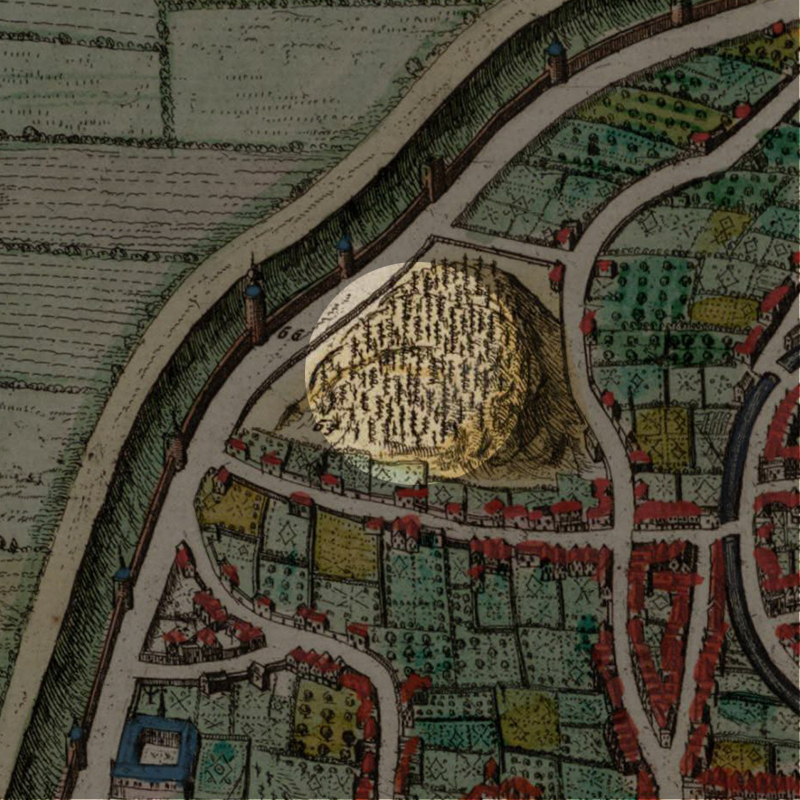ABOUT
On the 1649 map of Leuven in the Atlas van Loon, two areas were marked as Number 65 – Wijnberg (Wineberg). The correct one is the secondary school and agricultural school known as ‘De Wijnpers’ (the wine press), bordered by the Mechelsevest, the Donkerstraat and the Wijnpersstraat. The hill is the only remnant of Leuven’s historical status as a wine producer.
Origin
Leuven, the Wine-Producing Capital of Brabant
Before Leuven earned its current fame as the Beer Capital of Belgium, it was in fact the wine capital of the Duchy of Brabant.
In her article ‘Den wijnghaert soo bevrosen: De invloed van de kleine ijstijd op de Leuvense wijnbouw tussen 1400 en 1600.‘, Lena Walschap recounted the history of Leuven’s past as a wine producer. Apart from the larger vineyards in and around the city, which were not less than nine on a map from 1604, people cultivated wine grapes in their own gardens.
The height of Leuven’s wine production was in the 16th century.
But the production dropped drastically after the 17th century. Coupled with the rising demand for beer, Western Europe was experiencing the Little Ice Age. The initial phase of the climate change lasted from 1290 to around 1400. Then the coldest period set in from 1645 to 1715.
With wet summers, freezing winters and frosty spring, many wine producers had to give up their trade.
Additionally, the colonisation of the Americas brought in a greater quantity of silver into Western Europe. This led to inflation, leaving people to abandon wine for the cheaper alternative of beer. Above all, whilst the wine production in Leuven never completely stopped and even lasted into the 18th century, the bad quality of the wine due to the chilly summers coupled with its exorbitant price eventually destroyed the wine production in Leuven.
The Abdij Onze-Lieve-Vrouw ten Wijngaert (Abbey of the Our Lady of the Vineyard) a Cistercian convent located where the Voer river and the Dijle river meets, bore testament to Leuven’s history as the wine capital of Brabant.
The Ducal Vineyard
In 1121, the Duke of Brabant Godfried I established a vineyard in the hills south of his castle on Keizersberg. This was the largest vineyard of Leuven, and became known as the ‘Wijnberg‘ (wineberg) or the ‘Wingerd‘ – the local version of ‘wijngaerd‘ (vineyard).
Despite the decimation of Leuven’s wine production, it is remarkable that the whole area of the Wijnberg retains its agricultural nature up until this day.
What's so special about this place?
The 16th-century wine press – De Wijnpers
Where the Wijnperstraat meets the Donkerstraat, stands a beautiful 16th-century building called ‘De Wijnpers‘ (the wine press).
In 1551, the Abbot of the Sint-Geertruisabdij (St Gertrude’s Abbey) Pieter Was, had this wine press built to replace an older, run-down building from 1418. The Sint-Geertruisabdij owned several vineyards and its wine production must have been large considering the size of the Wijnpers.
But with the fall of the wine production in Leuven, the building fell out of use and was sold to the city in 1788, after which it served as a farmhouse.
After a thorough restoration in 1913, the Wijnpers became the property of the Brabant province, which placed a school there.
The Wijnpers became a protected building in 1938 and currently houses the ‘Provinciale School voor Moes- en Tuinbouw‘ (provincial school for horticulture).
The building name ‘De Wijnpers‘ thus became the name of the street and the whole area of the Wijnberg.
The Protected Mulberry Tree
Right by the Wijnpers is a huge black mulberry tree (Morus nigra).
Its trunk measures 2.76m around and its crown diameter is 17m. Based on these measurements, this tree is one of the oldest specimens in the whole region. Together with the Wijnpers building, the two form a historical unity.
Current situation
The secondary and technical school ‘De Wijnpers – Provinciaal Secundair Onderwijs‘ is the modern buildings on top of the Wijnberg hill by the Mechelsevest. The rest of the terrain belongs to the provincial horticultural school, retaining its unbroken agricultural nature since the 12th century.
It is one of the highest points of Leuven where I regularly enjoy taking a walk. It offers one of the best panoramic view of the city, and one of the best secrets kept even from Leuven’s inhabitants.
Wijn Production is back in Leuven
In recent years the horticultural school started cultivating wine grapes on the slopes of the hill just next to the Wijnpers, after more than 300 years! The school is producing around 500 bottles per year as part of its curriculum. The wines are currently only available as gifts and on special Open House days.
The Newly-Renovated Wijnpershuis (Wine Press House)
The press building itself is now called the Wijnpershuis (wine press house). The medieval building has in the 2020s finally been fully renovated, retaining many of its features, such as the stairwell, the original beams, the great oak doors, and the cellar where the wine barrels were stored! It currently serves as an office space for the school and is open for guided tours only on open house. Check out the photos below for a special insight into the preserved architectural features of the Wijnpershuis.
Sources:
https://inventaris.onroerenderfgoed.be/erfgoedobjecten/42561
https://inventaris.onroerenderfgoed.be/erfgoedobjecten/131504
https://www.dewijnpers.be/
https://leuven-plus.be/wp-content/uploads/2020/04/Buurtwandeling-Mannenstraat.pdf
https://levendleuven.files.wordpress.com/2011/05/flyer-levend-leuven-site-van-humbeeck-piron-wijnperssite-voor-web.pdf
https://scriptiebank.be/scriptie/2019/den-wijnghaert-soo-bevrosen-de-invloed-van-de-kleine-ijstijd-op-de-leuvense-wijnbouw
HOW IT LOOKS LIKE TODAY
Click on the zoom icon to view the full size.











































